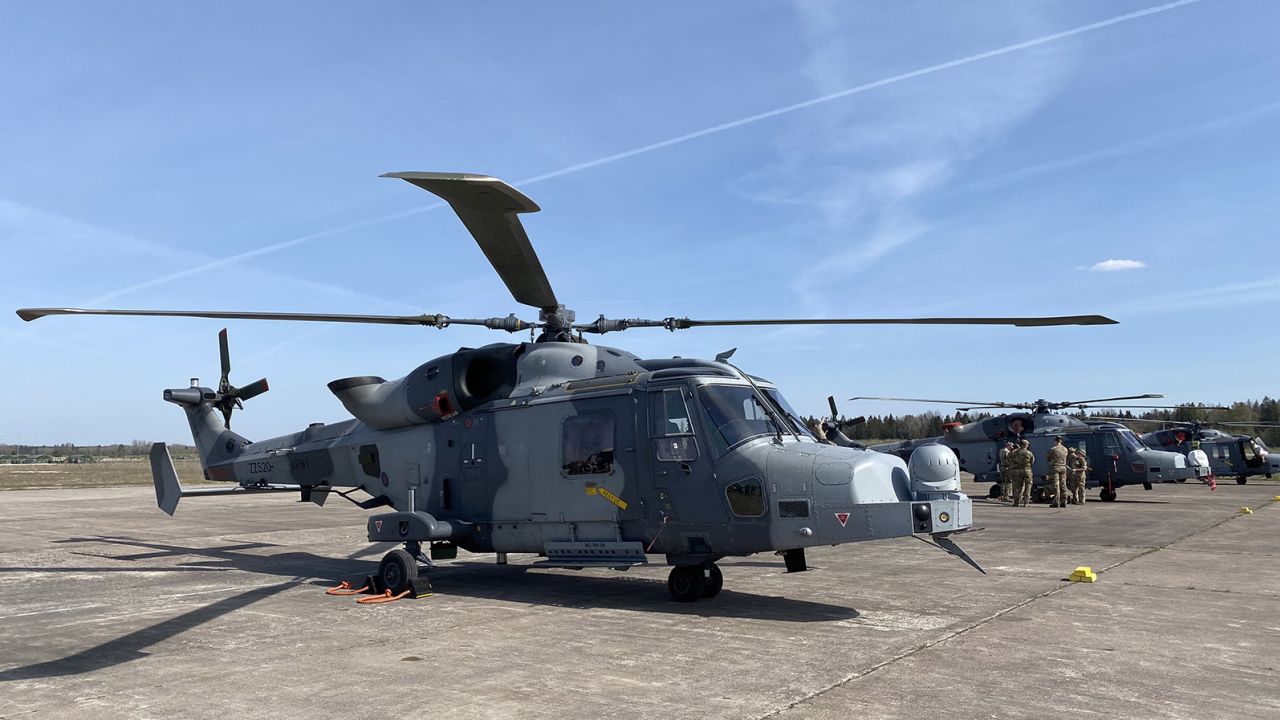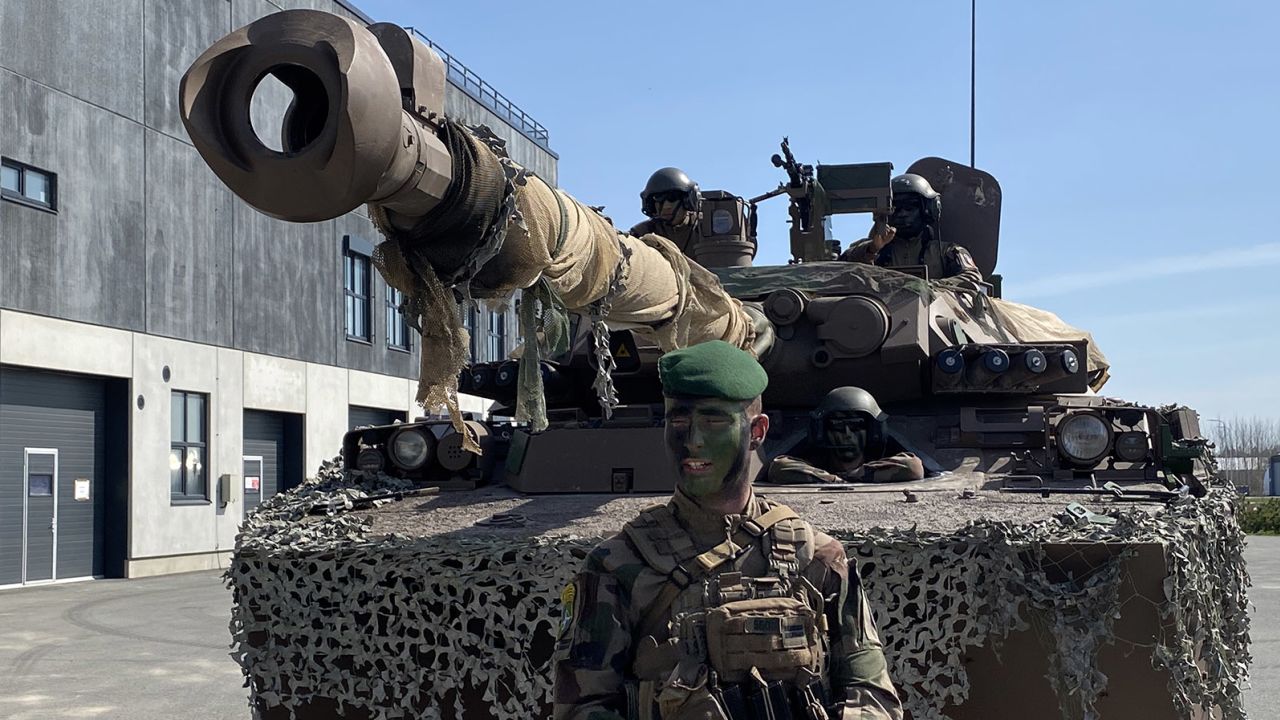Tallinn, Estonia
CNN
—
In 2014, when Russia illegally annexed Crimea and began fomenting conflict in Ukraine’s Donbas region, there was a short phrase that captured the fear that Moscow would try to grab still more territory, this time in Estonia: “Is Narva next?”
Narva, Estonia, a city of 60,000 people, is as close as you can get to Russia in Europe. It sits high on the western bank of the Narva River, its 13th-century castle proudly flying the blue, black and white flag of Estonia. On the opposite bank stands Ivangorod, population roughly 10,000, with its 15th century fortress, atop which flutters the red, blue and white flag of Russia.
Between them stretches a bridge straight out of a Cold War movie, fortified with chain link fences and barbed wire, the route that Russian tanks might take to invade Estonia – or so the theory goes. So far, however, Russian tanks have not rolled over the bridge and Estonia, a small nation of 1.3 million people but a staunch member of NATO, is intent on making sure that never happens.
At Tapa military base, Estonia’s largest, a two-hour drive west from Narva, “Spring Storm” is under way, a large NATO military exercise with approximately 14,000 troops from 11 countries, testing the preparedness and interoperability of Estonia’s flagship 1st and 2nd Infantry Brigades with NATO troops from Denmark, France, Italy, Latvia, Poland, Britain and the US.
One day before the Lennart Meri security conference began in the capital Tallinn – an annual meeting of political leaders, military figures and academics – I joined a group of journalists observing preparations for the exercises.
At one staging area, French Foreign Legion soldiers in fierce green camouflage face paint showed us France’s AMX-10 RC armored fighting vehicle (dubbed the “Tank Destroyer”) that’s being used in Ukraine. Next to it – a Caesar self-propelled howitzer with its 155mm 52 caliber gun that can shoot 40 kilometers (25 miles.) We hopped a bus to another part of the base see Wildcat and Apache attack helicopters flown in by British pilots the day before.
“Estonia has a bad neighbor,” Major General Veiko-Vello Palm, Deputy Commander of the Estonian Defense Forces, tells us. Readiness is key, he said. ‘We won’t have much warning.”
And if Russia tries to invade? “Let them try,” he added with a wry grin.
At last year’s Lennart Meri Conference, which took place just eleven weeks after Russia’s full-scale invasion of Ukraine, the mood among the Estonian experts, including government officials, military officers and diplomats, was a respectful but firm: “We told you so:” Told you that Russia would invade. Told you that Moscow has long-term hostile strategic goals. Told you that Vladimir Putin won’t stop with Ukraine.
This year, with NATO united, Estonia’s neighbor Finland joining the defense alliance and Sweden expected to follow suit, with Russian forces suffering devastating casualties in Ukraine, the mood in Tallinn among many European and American participants was confident, but the Estonians remain cautious. “The times aren’t going to be easier for us in the near future,” Major General Palm warned. “Russia’s threat is not getting smaller.”
Vladimir Putin has a bigger goal than Ukraine, Estonian officials say: to dissolve the rules-based world order and as long as that’s the goal, Russia will remain the most dangerous immediate and long-term threat to the West.
“We know the Russians and Russian know us,” one official told us. “We watch them, and they watch us. We think we know roughly what makes them tick.”
Like parts of Ukraine, Estonia was illegally annexed and occupied by the Soviet Union. Thousands of Estonians died after being loaded onto cattle cars and exiled to Siberia.
Estonians at the conference were adamant: Unless Russia is utterly defeated in Ukraine, there is no reason to expect Putin will change his strategic objective. Their NATO allies, they said, are still operating on several “myths” about the war. Like the idea that this is “Putin’s war.” It’s not, the Estonian Ministry of Defense claims in a discussion paper. In spite of massive Russian casualties on the battlefield, there’s widespread support for the war among the Russian public. “The imperialist mindset is historically rooted in Russia,” the authors argue.
“Russia has never been a democratic country and is unlikely to become one…Russia’s leadership has been preparing the society for a large-scale war with the West for the past 20 years…Even if Putin were stopped, the next man in line would not be any different, because Russia is not any different.”

Estonian Defense officials insist that its allies are still too cautious, afraid of “uncontrollable escalation,” wary that Putin will retaliate with nuclear weapons. That, the Estonians maintain, allows Russia not only to control escalation but to control the West’s strategy. “War of attrition is a very heavy price for perceived strategic stability,” they say. “Going forward, we must strive to refrain from paralyzing self-deterrence and excessive fear of escalation.”
The first day of the conference I grabbed a seat at a standing-room only discussion with Russian journalists who fled Russia after Moscow invaded Ukraine. They’ve been living in the Baltic nations, in Georgia, Germany and the Netherlands, unsure when – or even if – they will be able to go home. As usual with Russians, the discussion quickly turns philosophical.
“The repression has grown so great,” says one TV journalist. “There’s something deeply wrong with my country,” says another, “there’s a total rejection of political responsibility…We all are hostages of a madman.”
One journalist, as Russians often do, tells a Soviet-era joke: Communist party leader Leonid Brezhnev announces that tomorrow, the state will start to execute people. “Any questions?” he asks. “Should we bring the rope?” pipes up one timid person.
Many Russians have been de-politicized by the Kremlin. “They simply don’t have any opinion on the war,” one journalist explains. “It’s like North Korea.” Russians are confused, torn, not even asking themselves whether they support the war or not. They tune out news, focusing on everyday concerns.

Several Russians at the conference said they feel personally responsible for the horrors Russia is unleashing on Ukraine. “We will have to pay for it for many years to come,” one said. Russia has never confronted even its Soviet past, they all agreed, and there’s little likelihood it will examine, let alone atone for what it now is doing to Ukraine.
What’s more, Vladimir Putin is winning support for the war from so-called “swing states” and nations in the Global South.
Fiona Hill, a senior fellow at the Brookings Institution and former senior director for European and Russian affairs at the US National Security Council, gave the keynote address and engaged in a kind of virtual debate with Putin, insisting this is not, as he argues, a “proxy war” between the US or the “collective West” and Russia. The Ukraine war, she said, “is now effectively the reverse—a proxy for a rebellion by Russia and the ‘Rest’ against the United States.”
Russia, she said, “has cleverly exploited deep-seated international resistance, and in some cases open challenges, to continued American leadership of global institutions.” The so-called “Rest” of the world “seek to cut the U.S. down to a different size in their neighborhoods and exert more influence in global affairs. They want to decide, not be told what’s in their interest.”
This year at the Lennart Meri conference the Estonians aren’t saying “We told you so.”
But, in the conference halls in Tallinn, and at the Tapa military base, they are adamant that Russia must be held accountable for its crimes in Ukraine as well as deterred from any further aggression. It’s vital for security in Europe, and in the world, they say, and for the Estonian nation’s survival. They know they will have to live with their big neighbor to the east for a very long time.